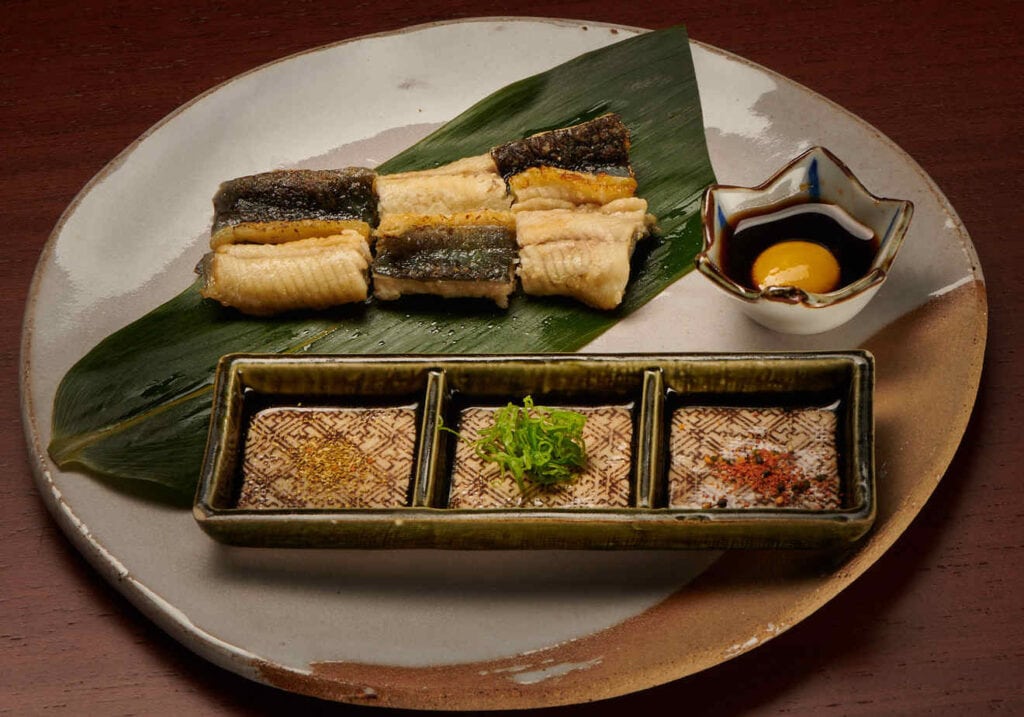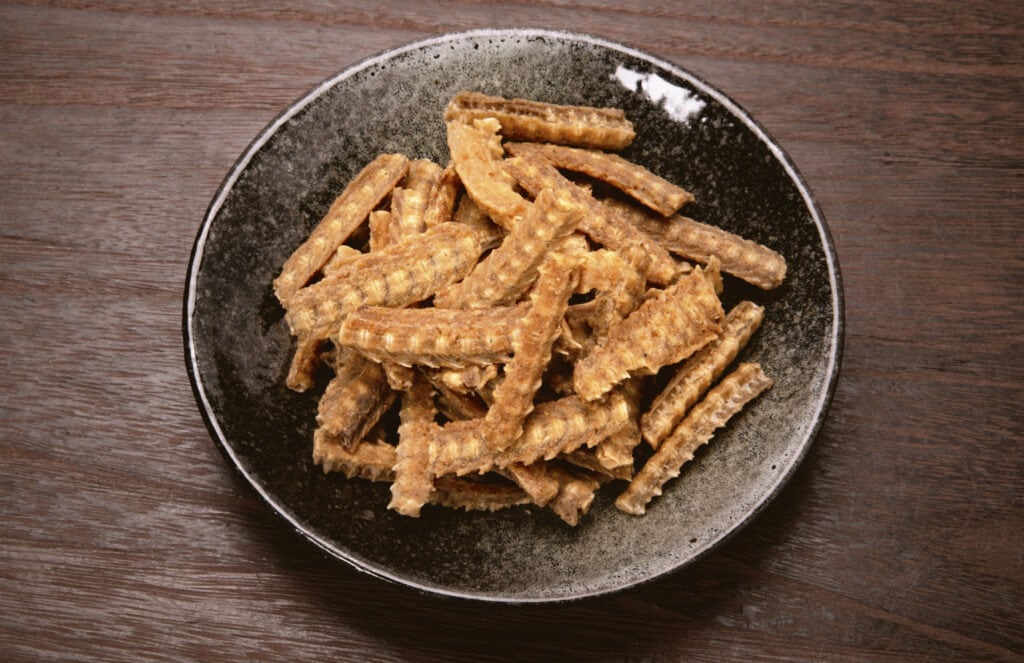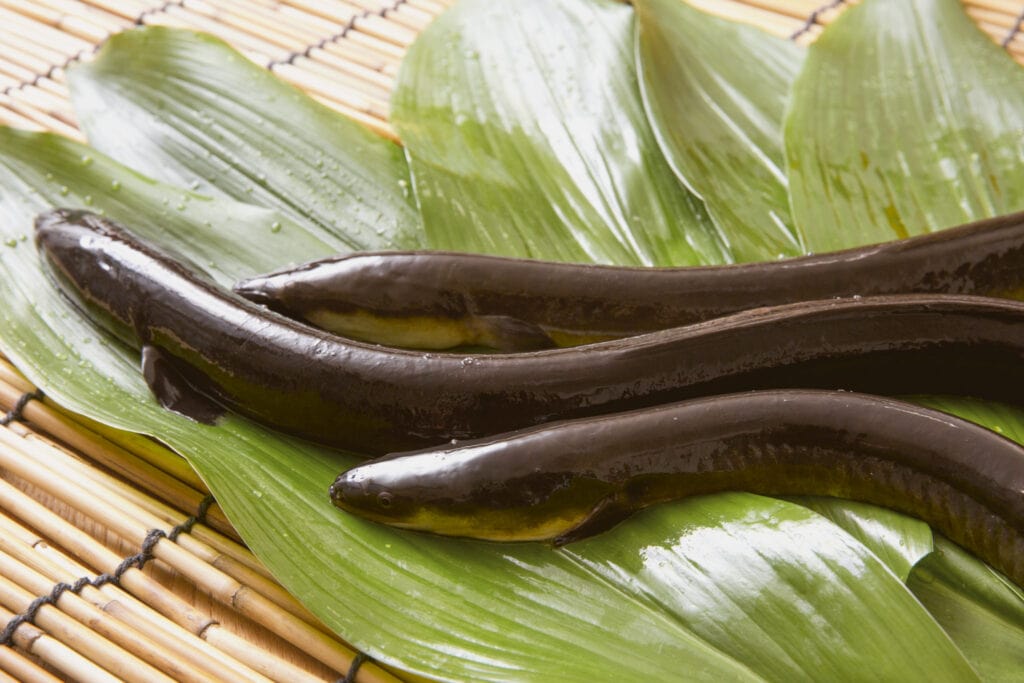Eel is a classic of Japanese cuisine. In Germany, the fish is mainly enjoyed smoked, but in Japan there are many different ways of preparing it.
"Unagi" is so much more than nigiri, the preparation in a form of sushi. Alone in Sushi the eel has already an extensive tradition and is refined in quite different ways! Here you can learn the interesting story about unagi: eel in Japanese.
Unagi (鰻) is known in Germany as freshwater eel (biological: Anguilla Japonica). At first glance, the long, snake-shaped fish may not seem like a delicacy. Nevertheless, it has been popular in Japan for many centuries.
In every region of Japan, in both smaller and larger cities, you can find restaurants that specialize in preparing eel. They are easy to recognize: On the noren, the curtain that traditionally hangs in the doorway, you'll find the character "う" (equivalent to the Japanese "U"). The "う" not only stands for Unagi, the eel. Its shape is also reminiscent of the long, snake-shaped fish. Often the character is found in the name of the restaurants.

Please do not confuse: Saltwater eel is also eaten in Japan. However, it is called anago (穴子) and is prepared quite differently.
The saltwater eel Anago has nothing in common with Unagi, at least in the kitchen.
Eel especially popular in summer
Eel is not a seasonal food in the strict sense: In Japan, it is actually prepared all year round. But eel is especially popular in the hot, humid Japanese summer. This is because the fish has a high content of vitamins and minerals.
The sultry heat of summer is hard to bear, especially in the center of the country and on the coast. Here, people suffer from the so-called summer fatigue: when the thermometer rises to 28 degrees Celsius and above, and the humidity approaches the 100 percent mark, you simply feel listless. Eel is considered the perfect remedy to better endure this season. There is even a day in summer when unagi is traditionally served. That is Doyo Ushi no Hi (土用の丑の日), the day of the ox. Statistics show how strongly Unagi is associated with Doyo Ushi no Hi. One-third of the freshwater eels eaten in Japan are served on Doyo Ushi no Hi.
Why do people like to eat eel on the day of the ox?
The day usually falls between the 20th and the 27th of July. The calculation of the exact date is somewhat more complex. There are several reasons for this: In Japan, for a few traditional festivals and holidays, the Chinese lunar calendar is still commonly used, which divides the year according to the phases of the moon rather than the path of the sun. Unlike other Asian countries, however, the use of this calendar is no longer as pronounced in Japan.
And Japan is a large country, stretching far from north to south and covering many different climatic zones. Autumn is characterized by strong typhoons, which usually pass over the country from the Pacific Ocean in a southerly direction. Ox Day is about 18 or 19 days before the beginning of autumn. The official start of autumn in Japan is on September 22 (public holiday) - but the Day of the Ox does not follow the dates set by Western customs. Instead, it marks the hottest time of the summer.
How it came to the connection of ox and eel
Since ancient times, it has been said that a food that begins with "U" is good for health. Such dishes are for example Udon (うどん、thick wheat noodles), Uri (瓜, melon) or Unagi (鰻, eel). How did one get the idea to connect this Doyo Ushi no Hi, the day of the ox, with Unagi of all things? A closer connection between the land-dwelling ox and the eel is not known even in Japan... The day of the ox has its designation simply from the Chinese calendar. So it is not about a proverbial ox at all.
Towards the end of the Edo period (1603 to 1868), one day the owner of an eel restaurant complained to the scholar and writer Hiraga Gennai that his business was doing so badly in the hot summer days. The latter "invented" the promotional phrase "Today is Doyo-ushi". Since then, people have associated Doyo Ushi no Hi with eating eel.
A promotional phrase with a medical background
To do this, one must know: Hiraga Gennai was employed as a herbalist by Prince Matsudaira Yoritaka of Takamatsu from 1744. In 1752, he was sent to Nagasaki to study the pharmaceutical benefits of animals, plants and minerals. The results of his studies were later published in a six-volume pharmacological work (Butsurui hinshitsu, 物類品隲). The man came into contact in Nagasaki with the Dutch present there, engaged in Western studies and inventions, and became known, among other things, for his self-deprecating essays dealing with flatulence. One may therefore speculate that perhaps there is a grain of truth in it when the scholar recommended eel for health in the hot summer.
Not all grilled eel is the same: different ways of preparation.
Eel in Japan is prepared in various ways and processed almost holistically. Here is an overview of the most popular forms of preparation.
The most popular eel: Unagi no Kabayaki
Perhaps the most famous way to prepare eel is Unagi no Kabayaki (鰻の蒲焼). This is a complex dish: the gutted and cleaned eel is deboned in the first step.

Then you pull the fish prepared in this way on skewers and grill it over charcoal. Charcoal is popular, which is also made bincho, that is, from oak, which comes from Wakayama. The next step is to steam the eel, which is already cooked. This is to draw the excess fat out of the fish. However, this does not happen everywhere in Japan. In Osaka and the entire Kansai region, there is no steaming. Here, the eel simply stays on the grill longer. This also allows the fat to escape.

Only then is the eel coated with a sweet-tasting sauce and grilled a second time. This sauce is firmly attached to the eel. Our customers at sansaro know it from Unagi-Nigiri, which is an elongated piece of sushi with eel. Because the eel is already marinated in the sweet sauce, Unagi-Nigiri does not need soy sauce.

Secret recipe: The sauce to the eel
The basis of the sauce for eel is soy sauce. This is sweetened with various types of sugar and sugar syrup. In addition, there are various spices and a sweet sake. However, the exact mixture of the sauce is different in each restaurant and is the pride of the restaurant owners. This is also a special feature in Japan, which is not so common in Germany: The small, specialized restaurants often have only a handful of different dishes on offer, and the owner is also the cook and sometimes even the only waiter. Of course, the exact composition of the sauce to the eel is secret!
Unagi no Kabayaki is served on a bowl of rice. This is correctly called Unagi Donburi (鰻丼), or Una-don for short. Sometimes it is also referred to as Una-ju (鰻重). The latter means something like "eel stacked" and thus describes exactly what the dish looks like.
Even in Japan, eel is now a very special treat and not commonplace. If you treat yourself to such an exquisite meal, you will of course do so in a restaurant specializing in eel! Very important is the high-quality charcoal over which the eel is cooked. By the way, a survey showed that most Japanese eat eel twice a year or even less often (only 16.8 percent said they eat eel once every two or three months). That's interesting, because unagi is very popular!
White grilled eel: Shirayaki Unagi celebrates minimalism
Why mask the eel's strong inherent flavor with an elaborate sauce when you can celebrate and enjoy it? Shirayaki Unagi (白焼き鰻, literally "white grilled eel") does nothing to mask the sweet flavor of the fatty fish, but rather accentuates it.
The preparation of Unagi Shirayaki (白焼き鰻) is similar to the preparation of Unagi no Kabayaki just described. The difference is that the fish is only salted before grilling. So the sweet sauce, the second grilling course are omitted. Purists prefer this preparation, because it emphasizes the special flavor of the fish through the combination of barbecue flavors and the already slightly sweet taste of the fat.
Unagi Shirayaki in Munich
We are already proud of it: In our restaurant sansaro we have been preparing Shirayaki Unagi ourselves since 2015. In 2020, you could read in Gault Millau that a two-star chef in Munich offers eel in the form of Shirayaki Unagi. This is a speciality that is very rare in Germany. Accordingly, much admiration spoke from the article. Our guests can also enjoy the Shirayaki Unagi completely cut and prepared in our house - without having to pay for two stars...

Hitsumabushi: An eel in four courses
We continue our mental and culinary journey through Japan and are now in Nagoya. A specialty in Nagoya is Hitsumabushi (櫃まぶし). For this dish, a whole eel is gutted and cleaned. The fish is divided into four portions and prepared in four courses. In the first course, the eel in Nagoya is served simply with rice. In the second course, the eel is served with wasabi, scallions and nori cut into fine strips. For the third serving, everything is doused with Japanese green tea O-cha. The dish is somewhat reminiscent in appearance of ochazuke (お茶漬, but in the original prepared with fried salmon instead of eel). The hot tea soaks into the rice, spreading the flavors of wasabi, scallions and nori throughout the rice. The whole thing adds up with the sweet-tart flavor of the tea to a fine seasoning.

What happens to the fourth piece of eel that is left over? The fourth portion is prepared the way you like it best - or the way the cook prefers it.
In our restaurant we have Hitsumabushi during the Corona lockdown in our delivery service. offered and also explained in more detail the dish and its history.

Which sake goes well with Japanese eel?
Nose to Tail: Everything from the eel is prepared
Of course, a fish is not only fillet.
In Japan, as much as possible of a raw material is traditionally used. In the case of vegetables, this means that stalks, stems and flowers are also processed. In the case of eel, it means that small pieces of meat and the bones or bones can also be used - and for tasty dishes!
Nigiri sushi: grilled eel
For nigiri sushi, the eel is grilled. The grilled pieces of fish are coated with the typical sauce for eel, as all types of sauce in Japan are commonly called tare (垂れ). In this way, the strong flavor of the eel and the light sweetness of the sushi rice combine to create a charming harmony.
Hone Senbei - deep fried snacks with high calcium content
And then there are Hone Senbei (骨煎餅), a snack prepared from the bones. The bones are roasted, then deep fried and lightly salted. People like to eat this snack with sake or beer. Fish bones are particularly rich in calcium.
Not only the bones of the eel are used in Japanese cuisine. Other (small species) fish are dried whole, smoked and added to dishes. This is also done with small crabs or crustaceans, including the shell. So calcium supply is not a problem at all in traditional Japanese cuisine, although dairy products do not play a major role.

Sweet tamago-yaki with salty eel: Umaki
Wrapping pieces of eel in a Japanese omelet (卵焼き, tamago-yaki) yields so-called umaki (鰻巻き), which is particularly captivating for its combination of salty fish and sweet egg mixture.
Umaki has also been on the menu with us at sansaro for many years. Of course, Umaki is made by hand at our place. The Use of fresh eggs in organic quality is a matter of course for us (long before we were certified organic)!
Liver of eel grilled over charcoal
For Unagi no Kimoy-aki (鰻のきも焼き), the eel's liver is grilled over charcoal and served as a small snack seasoned with salt and sansho pepper. So the innards of the fish are also usable, albeit in a limited way.
Another way to prepare the eel's liver is in kimosuji (肝すじ), a light clear broth with dashi, mirin, soy sauce and mitsuba. Mitsuba (三つ葉) is a type of Japanese "parsley," a culinary herb in the umbellifer family. The taste of mitsuba is more delicate than parsley and is somewhat reminiscent of goutweed. The attentive lover of Japanese cuisine may not have missed the fact that in recent years we have always liked to offer Mitsuba from the ingenious Munich gardener Johannes Schwarz in our seasonal dishes.
Whole eel? Una-zukushi!
The "nose to tail" principle has become fashionable in recent years as a particularly sustainable, appreciative approach to food. In Japan, this has been practiced for many centuries. It is referred to as una-zukushi, the "whole eel.
Eel as a food with a long tradition
Eel is an important and popular component of Japanese cuisine. We are always surprised that our German guests have a bit of a hard time with the topic of eel. Perhaps it is because the fish is known in this country almost exclusively in smoked form? What a pity! Because in terms of taste, unagi simply has an incredible amount to offer. Always take a close look at the restaurant's menu when you eat unagi sushi. Are there any other dishes with eel? That would be an indication that the eel might even be freshly cut up in house. If not, you may be served industrially prepared ready-to-eat fillets. It goes without saying that taste and enjoyment are only truly given through artful handcrafting!
Traditional food: eel sung about in poems
It was not until the Edo period (1603 - 1868) that eel had become commonplace as a food in large sections of the population. However, this does not mean that the fish as a food was unknown before. We know thanks to the Man'yoshu (万葉集, literally the "collection of 1,000 leaves") that eel was known 1,200 years ago for its extremely nutritious meat and high content of vitamins and minerals. The Man'yoshu is a collection of poems and was compiled in the Nara period (710 - 794). It contains two poems in which the poet Otomo no Yakamochi recommends eel as food to a friend. The friend had apparently lost a lot of weight during a hot summer.
If we go back even further in the relationship of the Japanese to eel, we arrive at the late Jomon period. Preserved finds of bones and bones prove that eel was already used as food in Japan about 2,300 years ago.
We know of the high status that the eel enjoys as a mysterious animal in almost all cultures of East Asia and the island kingdoms of the South Pacific through New Zealand to the First Nations of the Americas. In Japan, if the eel was always the nutrient-rich food for the hottest and most exhausting part of the summer, it helped First Nations people survive the harsh, cold winters well. The Atlantic eel has already disappeared from many parts of the Americas and Europe. And the Japanese eel is also threatened.
Excursion into biology: How does an eel live?
When we look at the biology of the eel, we must note: Not all eels are the same.
Both the freshwater eel (Unagi,Anguilla Japonica from the family Anguillidae) and the numerous species of eels living in the sea (Anago, Conger myriaster from the family Congridae) and the hagfish or hogfish (Nuta-Unagi, Eptatretus burgeri from the family Myxinidae) are simply called eels in German usage. The freshwater eel is a special case. The fish has long been known in Japan and is popular as a food. But the fish is also a mystery. Unlike other fish, it lives in fresh water and only goes to the sea to spawn. This makes it a so-called catadromous migratory fish - in contrast, salmon, for example, which swims up rivers from the sea to spawn, is an anadromous migratory fish.
Freshwater eels are born in the ocean. There, the animals go through two metamorphoses, or larval stages. During this time, they migrate through the oceans and grow. When they reach a certain size, they let the tides carry them into the rivers. There they develop into what is known in Japan as shirasu unagi, or glass eel. The animals now live in the rivers and lakes for several years before returning to the sea to spawn.
Eel as an agricultural product
Each year, about 50,000 tons of eel are consumed in Japan, according to the Ministry of Fisheries. 99 percent of this amount of fish comes from aquaculture. The eels are caught as juveniles during their migrations in the estuaries and transferred to controlled rearing tanks in ponds. These are therefore the so-called shirasu unagi. There the animals are raised for about six months to a year. They are then shipped for further processing.
World's increasing popularity of Japanese cuisine puts pressure on eel stocks
Japanese cuisine has gained popularity worldwide in recent years. Various foods have experienced a real boom, and in the course of this the demand for eel has also steadily increased. On the other hand, the catch quota for Shirasu eel has been steadily decreasing over the last 40 years. Therefore, it became more and more urgent to study the animals and their habitat in detail. Today, the eel is listed as an endangered species by the IUCN.
Research subject eel
With all understanding for the traditional culture of Japan and the associated culinary delights: No eel is not the answer. For several years, a research team at the University of Tokyo, in collaboration with the Atmosphere and Ocean Research Institute, has been studying the eel's habitat. In 2011, a breakthrough was made: it was discovered that the Japanese eel spawns about 2,500 kilometers from Japan near the Western Mariana Islands. The fish migrate through the Philippine Sea, across the Philippines and up to Taiwan during the growth phase, driven by ocean currents. Only then do they arrive in Japan.
Research in different countries
The problem of declining eel populations is not only being investigated in Japan. Taiwan, China and South Korea have also been intensively researching eels since 2012 and exchanging information informally. To date, however, there is still no uniform approach to research.
Outlook to the future: Not without eel!
So far, it is not clear what can be done about the ever dwindling eel populations. Whether the countries involved will ever be able to agree on a joint conservation project is written in the stars. Meanwhile, Kinki University in Osaka, usually referred to simply as Kindai University, has been trying to find another solution. In 2016, the company succeeded in developing a catfish-like species whose meat tastes like eel. The fact that the catfish taste like eel is not only a breeding success. The diet of the animals also contributes to the characteristic taste. However, the fish must still be prepared as Unagi no Kabayaki - the taste of the sweet sauce could not yet be bred into the catfish.
Whether the eel-flavored catfish will ever become marketable, however, is not yet certain. But at least a possibility has opened up here to tackle the problem of the impending extinction of the shirasu unagi even as consumption continues to rise.
Japanese research approach to possible breeding of the eel
Fish from the lab could be a future?
Of course, this is not a unique development. Research projects are underway around the world to breed extinct and highly endangered animals. This is particularly important in terms of ensuring sufficient food for the world's population. Because, of course, eel is not just about unique flavor, but also about fat content, nutrients and food culture.
When we serve eel at sansaro restaurant, we do so with the awareness of preserving and passing on a piece of Japanese culture. Our dishes are prepared with deep respect for nature and these wonderful animals. We do not serve wild-caught eel, but rather aquacultured eel. Don't miss our seasonal specialties! See you soon at sansaro.








